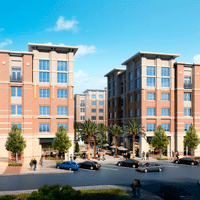After more than 30 years of building luxury multifamily developments, Houston-based Hanover Company broke ground on its latest project in College Park, Maryland, last summer. The 380-unit Hanover College Park, which includes 22,000 square feet of retail space and three restaurants, is poised to earn LEED Silver certification and stoke the fire of green development.
Although vice president Brandt Bowden is proud of the various LEED-certified projects Hanover has worked on, he says that being an energy-conscious company isn’t about chasing scores. It’s about making smart choices based on the timing of a project and its surroundings. “There’s been somewhat of a pushback on LEED recently, for a couple reasons,” Bowden says. “The first is because LEED is so inundated with projects lately. The second is because some characteristics of LEED don’t necessarily lead to more efficient buildings. Many aspects of LEED end up doing less intelligent things with the building.” He adds that because energy efficiency has become such a crucial issue for growing municipalities, many cities have adopted their own building standards, many of which are similar to LEED’s.

The Olivian is a 27-story Hanover Company apartment building in Seattle and has energy-efficient building systems, water-conserving fixtures, and natural lighting. Photos: Ed LaCasse
For Hanover, developing urban complexes that adapt to a city’s infrastructure and use little energy has been a natural step. Founded in 1981 by Bowden’s father, J. Murry Bowden (still the company’s acting CEO), Hanover began as a company focused on multifamily apartments in Houston. When the oil crash hit in 1985, Bowden says it was time to adapt. “We started developing in Florida, the Carolinas, the Southeast, and California,” he says. “Then, in 2000, we were building from Seattle, to Texas, to DC, to Philly, to Boston. We’re now building in 22 cities.”
Hanover has completed approximately 38,000 projects so far, totaling $7.5 billion. The vast majority of its projects are located in urban cores, a direction the company took about a dozen years ago, before many competing development companies had caught on to the national shift toward city centers. “People are really trying to reinvest in urban centers,” Bowden says.
Because of any given project’s proximity to various downtown areas, Hanover has had to adjust to whatever environment it finds itself in. Bowden says that he and his team often face two extremes: a pedestrian-friendly environment, or a more vehicular one. Whether they’re designing a building for a traffic-heavy city where ample parking is crucial (like the 58-unit Ashton Westwood development in Los Angeles) or for a dense location close to public transit (like Philadelphia’s Domus, close to the University of Pennsylvania), Hanover has to work with and around preexisting infrastructure.
Bowden cites the soon-to-open Hanover Rice Village as an example. The development, near a small, wealthy urban center in Houston, is located in a neighborhood largely made up of single-family homes. The neighborhood was desirable, but there hadn’t been a high-quality rental development there in almost two decades. Hanover had to accommodate for traffic-heavy Houston while also taking advantage of Rice Village’s walkable neighborhood, a balance Bowden says is a challenge for every project the company takes on.
“The goal was to create a project that could effectively deliver good value in terms of cost structure,” Bowden says. “Because we do new construction, we can solve issues like parking that the old space couldn’t have. … We wanted a project that could be consistent with the neighborhood and bring vibrancy to the area.”

